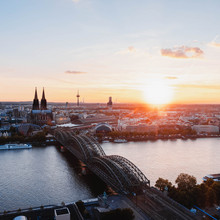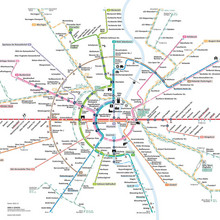Travel & Accommodation
Travel to Cologne
The German Sport University is located close to two important airports. Düsseldorf airport (DUS - all major airlines) is as close as 30 minutes using regional trains to Cologne Central Station. From Cologne airport (CGN - large number of low-cost carriers) Cologne Central Station can be reached within 15 minutes time by local train.
The Cologne Central station can be reached from many of Germany's neighboring countries in a reasonable amount of time. To take advantage of saver fares, early booking is recommended.
From Cologne Central Station there are several means of public transportation to the German Sport University (tram, bus) that take around 20 to 25 minutes to the campus of the GSU.
Accommodation
Hotel reservations have to be made individually.
We blocked several rooms at two hotels closest by - please use the references upon your reservation to make sure you benefit from the price conditions.
- Guest house - on campus of the GSU. Double or single room for €59.50/night incl. breakfast. Reference:"CESH 2023"
Contact: gaestehaus@dshs-koeln.de or phone +49 221 4982 2470. - Essential/Dorint Hotel Köln Junkersdorf - tram stop "Mohnweg". Price per double 114€, single 104€ per night (incl. breakfast). Reference: "CESH"
Contact: info@dorint.com or phone +49 221 48567 0
If available, we recommend to pick an alternative hotel within walking distance to tram line 1, stop "Junkersdorf". Click here to access theRoute Network Plan public transport Cologne (KVB).
Possible hotel booking websites:
Selection of hotels:
Selection of Hostels:
Key Facts about Cologne
Cologne is Germany's fourth-largest city and is the largest city both in the German Federal State of North Rhine-Westphalia and within the Rhine-Ruhr Metropolitan Area, one of the major European metropolitan areas with more than ten million inhabitants.
Cologne is located on both sides of the Rhine River. The city's famous Cologne Cathedral (Kölner Dom) is the seat of the Catholic Archbishop of Cologne. The University of Cologne (Universität zu Köln) is one of Europe's oldest and largest universities.
Cologne was founded and established in the first century AD, as the Roman Colonia Claudia Ara Agrippinensium in Ubii territory. It was the capital of the Roman province of Germania Inferior and the headquarters of the military in the region until occupied by the Franks in 462. During the Middle Ages it flourished as one of the most important major trade routes between east and west in Europe. Cologne was one of the leading members of the Hanseatic League and one of the largest cities north of the Alps in medieval and renaissance times. Up until World War II the city had undergone several other occupations by the French and also the British. Cologne was one of the most heavily bombed cities in Germany during World War II. The bombing reduced the population by 95% and destroyed almost the entire city. With the intention of restoring as many historic buildings as possible, the rebuilding has resulted in a very mixed and unique cityscape.
Cologne is a major cultural center of the Rhineland; it is home to more than thirty museums and hundreds of galleries. Exhibitions range from local ancient Roman archeological sites to contemporary graphics and sculpture. The Cologne Trade Fair hosts a number of trade shows such as Art Cologne, imm Cologne, Gamescom, and the Photokina.
Attractions & Culture in Cologne
Cologne Cathedral
Cologne Cathedral is a building of superlatives that is the centre and hallmark of this city on the Rhine. The cornerstone of this Gothic cathedral was laid on the Feast of the Assumption of Mary on 15 August 1248. The previous building was apparently no longer deemed impressive enough to house the remains of the Three Wise Men, which Archbishop Rainald von Dassel had brought to Cologne from Milan after the latter city was conquered in 1164. Because of these relics, the cathedral became one of the most important places of pilgrimage in Europe. Its two massive towers have dominated the city’s skyline since their completion in 1880. At 157.38 metres, the northern tower is 7cm taller than the southern one. More
Cologne Museums
Cologne has many museums, including several that are internationally renowned. While the Wallraf-Richartz-Museum & Fondation Corboud houses fascinating medieval paintings and an important collection of Impressionist paintings, the Museum Ludwig is home to the largest Pop Art collection outside of the USA. The glass collection at the Romano-Germanic Museum is unlike any other in the world, and at the Museum of Applied Arts design objects are presented in close relationship to works of fine art. An important collection of sacred art from the medieval period is presented in the Museum Schnütgen, and the Rautenstrauch-Joest-Museum features an impressive ethnological collection. More
Cologne’s Old Town
Cologne’s Old Town has a distinctive historical charm. Visitors are drawn by its rustic narrow alleyways lined with traditional old houses. Innumerable breweries, pubs and restaurants invite passersby to linger. Here you can enjoy a draft Kölsch beer or try Cologne’s typical Halver Hahn sandwich. More
Rheinauhafen District
The newly designed, restructured Rheinauhafen waterfront complex is a young and attractive district of Cologne. The 210,000 m² development, which is located right on the Rhine, not far from to the city center, has quickly become established as one of Cologne’s popular attractions. The waterfront district features a mix of modern residential and office buildings interspersed with many cafés, restaurants, and galleries. And visitors with a passion for architecture and culture will also find points of interest in the Rheinauhafen. More
Arts and Culture
Stories about cinema, art, literature, music and theatre in Cologne. More
Sources
KölnTourismus GmbHhttps://www.cologne-tourism.com/see-experience/
Wikipediahttp://en.wikipedia.org/wiki/Cologne

